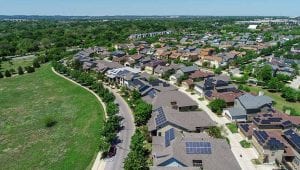Among those celebrating SolarReserve’s winning tender to build a 150MW solar tower and molten salt storage plant in the South Australian town of Port Augusta are the members of local lobby group, the Repower Port Augusta Alliance.
And rightly so. The community-based group has spent the last five years campaigning for solar thermal to replace the region’s old coal-fired power plants, which were shut down by Alinta Energy in May last year.
“This is a huge people powered win for our community and South Australia,” said Repower chair and former coal plant worker, Gary Rowbottom, in comments on Monday.
“We thank Premier Weatherill and the South Australian government for listening to our community’s overwhelming call and backing this innovative, job-creating solar technology that locks in Port Augusta as an energy powerhouse for SA once again,” Rowbottom said.
But Port Augusta is not the only former coal community to be embracing – and even leading – the shift to renewable energy generation and jobs.
In northern Queensland, for example, the transformation of the Collinsville coal-fired power station into a 42MW solar farm is underway, with the backing of the Clean Energy Finance Corp.
CEFC large-scale solar lead Gloria Chan said in May that the green bank was particularly excited about the Collinsville project’s potential to showcase how old power station sites could be repurposed for renewable generation.
“Since our program’s launch in September 2015, the large-scale solar sector has transformed,” Chan said. “Solar has become a progressively cost-competitive energy source and we are now at the tipping point of seeing Australian utility-scale solar projects becoming commercially viable without grant funding.”
And just last week, another 200MW of large-scale solar generation was locked in for the former coal hub, with Edify Energy reaching financial close on its 150MW Daydream solar farm and 50MW Hayman solar farm, both near Collinsville.
Back in South Australia, just 12km from Port Augusta, Reach Energy – which is headed up by the former head of the owners of the recently closed Hazelwood brown coal generator in Victoria – is building the first 220MW of the 300MW Bungala solar farm. The project is said to be “battery power ready.”
And 15km west of Port Augusta, a 212MW wind farm is being built by Nexif Energy at Lincoln Gap.
Meanwhile, the Aurora solar tower and molten salt storage plant SolarReserve has been contracted to build in Port Augusta takes the coal to renewables transition to another level. As we have reported, it will be the biggest solar thermal plant with storage in the world, and is expected to create 700 jobs during construction, 50 ongoing jobs, and create numerous local manufacturing opportunities.
“The Port Augusta story is a stark example of the transition of the South Australian economy, with the closure of a dirty coal fired power station, and now the commissioning of this world leading renewable energy project,” said SA Premier Jay Weatherill on Monday.
“This is a massive game-changer for the energy market in this country… And it has the lovely side-benefit of making sure that there is a transition for the people of Port Augusta from old coal to new renewable,” he said.
“It’s a great jobs story,” said SolarReserve CEO Kevin Smith in comments on Monday.
“We see a workforce in the Port Augusta area that have real power plant experience, and this is a real power plant – it’s got a full steam cycle steam turbine on the back end, so we need qualified constructors and operators in order to keep this going and competitive.”
“And that’s exactly one of the reasons why we chose the Port August area, because it has that experienced workforce.”
But Port Augusta, like Collinsville, is also a great community health story. Just this week, new data has revealed that Australia’s coal power plants emit more air pollution than those in China, Europe and the US; have lower emission standards; and fail to use readily available pollution reduction technology.
This pollution – which has been linked with higher rates of asthma, chronic lung disease and lung cancer – is, of course, the most damaging to communities living close by. But it can also travel 100km or more, according to the medical group Doctors for the Environment Australia.
“Why are we permitting these plants to emit more than 30 toxic substances to the air we breathe?” asked DEA spokesperson Dr David Shearman, in a statement on Tuesday.
“It’s high time that both state and federal governments get their act together and make the transition to clean power sources such as wind, solar and other alternatives.”
DEA says the closure of power plants should be based on the level of pollutants, putting Victoria’s Latrobe Valley and NSW’s Hunter Valley high on the agenda: “Yallourn and Loy Yang in Victoria; Mt Piper, Liddell, Bayswater, Eraring and Vales Point in New South Wales; Tarong in Queensland,” it says.
Port Augusta and Collinsville are just the tip of the iceberg.











